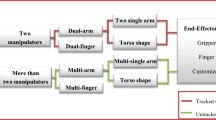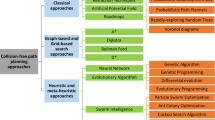Abstract
This paper presents a unique optimal torso design selection technique for the dual seven-degree-of-freedom robot arm. This optimal design enhances the robot end-effector’s workspace with less operational stress. The selection procedure incorporates the von Mises stress and robot workspace analysis in different robot-torso mounting configurations. The torso design selection strategy includes the von Mises stress calculation numerically and by using SolidWorks static analysis for robot arm considered as bolted-fixed end cantilever beam. Followed by robot end-effector workspace analysis using inverse kinematics, which determines the maximum area covered by manipulated robot end-effector in 2-dimensional (2D) and 3-dimensional (3D) space. Subsequently, introducing a selection function for torso design. This selection function is calculated based on weighting coefficients (priority given to stress and workspace), von Mises stress, and workspace area. The selection technique concludes that the torso design with upper-arm mounting configuration is optimal for current robot application, i.e., assembly.
Similar content being viewed by others
References
C.-N. Cho, J.-H. Kim, S.-D. Lee and J.-B. Song, Collision detection and reaction on 7 DOF service robot arm using residual observer, Journal of Mechanical Science and Technology, 26(4) (2012) 1197–1203.
E.-J. Kim, K. Seki and M. Iwasaki, Motion control of industrial robots by considering serial two-link robot arm model with joint nonlinearities, Journal of Mechanical Science and Technology, 28(4) (2014) 1519–1527.
C. Park and K. Park, Design and kinematics analysis of dual arm robot manipulator for precision assembly, 6th IEEE International Conference on Industrial Informatics (2008) 430–435.
H. M. Do, C. Park and J. H. Kyung, Dual arm robot for packaging and assembling of it products, IEEE International Conference on Automation Science and Engineering (CASE) (2012) 1067–1070.
A. Pezhman, J. Rezapour and M. J. Mahmoodabadi, An optimal hybrid adaptive controller based on the multi-objective evolutionary algorithm for an under-actuated nonlinear ball and wheel system, Journal of Mechanical Science and Technology, 34 (2020) 1723–1734.
T. Asfour and R. Dillmann, Human-like motion of a humanoid robot arm based on a closed-form solution of the inverse kinematics problem, Proceedings IEEE/RSJ International Conference on Intelligent Robots and Systems (IROS), 2 (2003) 1407–1412.
S.-J. Huang, S. Liu and C.-H. Wu, Intelligent humanoid mobile robot with embedded control and stereo visual feedback, Journal of Mechanical Science and Technology, 29(9) (2015) 3919–3931.
L. Fiorio, A. Scalzo, L. Natale, G. Metta and A. Parmiggiani, A parallel kinematic mechanism for the torso of a humanoid robot: design, construction and validation, IEEE/RSJ International Conference on Intelligent Robots and Systems (IROS) (2017) 681–688.
B. Hu et al., Reachable workspace determination for a spatial hyper-redundant manipulator formed by several parallel manipulators, Journal of Mechanical Science and Technology, 33(2) (2019) 869–877.
M. Lopes, R. Beira, M. Praça and J. Santos-Victor, An anthropomorphic robot torso for imitation: design and experiments, IEEE/RSJ International Conference on Intelligent Robots and Systems (IROS), 1 (2004) 661–667.
P. Yao, T. Li, M. Luo, Q. Zhang and Z. Tan, Mechanism design of a humanoid robotic torso based on bionic optimization, International Journal of Humanoid Robotics, 14(04) (2017) 1750010.
J. Reinecke, B. Deutschmann, A. Dietrich and M. Hutter, An anthropomorphic robust robotic torso for ventral/dorsal and lateral motion with weight compensation, IEEE Robotics and Automation Letters, 5(3) (2020) 3876–3883.
A. Rodić, B. Miloradović, S. Popić and Đ. Urukalo, On developing lightweight robot-arm of anthropomorphic characteristics, New Trends in Medical and Service Robots, Springer, 38 (2016) 33–46.
R. S. Jamisola, P. Kormushev, D. G. Caldwell and F. Ibikunle, Modular relative jacobian for dual-arms and the wrench transformation matrix, 7th International Conference on Cybernetics and Intelligent Systems (CIS) and Conference on Robotics, Automation and Mechatronics (RAM) (2015) 181–186.
F. Wirnshofer, P. S. Schmitt, P. Meister, G. V. Wichert and W. Burgard, State estimation in contact-rich manipulation, International Conference on Robotics and Automation (ICRA) (2019) 3790–3796.
A. Pervez and J. Ryu, Safe physical human robot interaction-past, present, and future, Journal of Mechanical Science and Technology, 22(3) (2008) 469–483.
J. E. Akin, Concepts of stress analysis, Finite Element Analysis Concepts: via SolidWorks, World Scientific, 1 (2010) 35–67.
R. H. Shih, Basic beam analysis, Introduction to Finite Element Analysis using SolidWorks Simulation, SDC Publications, 1 (2014) 7–2–35.
F. Zacharias, C. Borst and G. Hirzinger, Capturing robot workspace structure: representing robot capabilities, International Conference on Intelligent Robots and Systems (2007) 3229–3236.
K. Kreutz-Delgado, M. Long and H. Seraji, Kinematic analysis of 7-DOF manipulators, The International Journal of Robotics Research, 11(5) (1992) 469–481.
M. G. Jung, Y. J. Gon, P. S. Oh and M. C. Lee, Study on robust control of industrial manipulator for assembly based on SMCSPO, International Conference on Advanced Intelligent Mechatronics (AIM) (2018) 33–38.
D. R. Smith, Bodies and motions, An Introduction to Continuum Mechanics-After Truesdell and Noll, SMIA, Springer Science and Business Media, 22(1) (2013) 87–98.
R. Jain, M. N. Zafar and J. C. Mohanta, Modeling and analysis of articulated robotic arm for material handling applications, IOP Conference Series: Materials Science and Engineering, 691(1) (2019) 1–8.
J. E. Shigley, Load and stress analysis, Shigley’s Mechanical Engineering Design, 8th Ed., McGraw-Hill Education (2006) 68–121.
S. Oman and M. Nagode, Bolted connection of an end-plate cantilever beam: the distribution of operating force, Strojniški vestnik-Journal of Mechanical Engineering, 63(11) (2017) 617–627.
S. Park and M. C. Lee, 7DOFs robot numerical approach method with Jacobian, International Conference on Information and Communication Technology Robotics (ICT-ROBOT) (2018) 1–4.
H. Khan, H. H. Kim, S. J. Abbasi and M. C. Lee, Real-time inverse kinematics using dual particle swarm optimization DPSO of 6-DOF robot for nuclear plant dismantling, Proceedings of IFAC, 53(2) (2020) 9885–9890.
H. Khan, S. J. Abbasi and M. C. Lee, DPSO and inverse jacobian-based real-time inverse kinematics with trajectory tracking using integral SMC for teleoperation, IEEE Access, 8 (2020) 159622–159638.
H. Khan, S. J. Abbasi, H. H. Kim and M. C. Lee, Robot arm end-effector reaction force estimation for part assembling process using sliding perturbation observer, International Automatic Control Conference (CACS) (2020) 1–5.
Acknowledgments
This research was funded by the Technology Innovation Program (10073147, Development of Robot Manipulation Technology by Using Artificial Intelligence) funded by the Ministry of Trade, Industry & Energy (MOTIE, Korea).
Author information
Authors and Affiliations
Corresponding author
Additional information
Hamza Khan received the B.S. in Mechatronics Engineering from Air University, Islamabad, Pakistan, in 2018, and the M.S. in Mechanical Engineering from Pusan National University, Busan, South Korea, in 2021, where he is currently pursuing the Ph.D. degree in Mechanical Engineering. His research interests include linear/nonlinear control, force control, robot manipulators kinematics and dynamics and system identification.
Saad Jamshed Abbasi received the B.S. in Mechatronics Engineering from Air University, Islamabad, Pakistan, in 2015, and the M.S. in Mechanical Engineering from Pusan National University, Busan, South Korea, in 2018, where he is currently pursuing the Ph.D. in Mechanical Engineering. His research interests include nonlinear control, robot manipulators, and system identification.
Min Cheol Lee received the Ph.D. in Applied Physics and M.S. in Engineering Science from the University of Tsukuba, Tsukuba, Japan, in 1991 and 1988, respectively. He received his B.S. in Mechanical Engineering from Pusan National University, Busan, Korea in 1983. He is a Full Professor of Mechanical Engineering, Pusan National University, South Korea. His research interests include intelligent robot control, autonomous mobile robot, medical robot, signal processing to identify a system, robust control of a system, sensor application, and mechatronics.
Rights and permissions
About this article
Cite this article
Khan, H., Abbasi, S.J. & Lee, M.C. Optimal torso design selection for dual 7-DOF robot arm using von Mises stress and workspace analysis. J Mech Sci Technol 35, 4149–4159 (2021). https://doi.org/10.1007/s12206-021-0827-2
Received:
Revised:
Accepted:
Published:
Issue Date:
DOI: https://doi.org/10.1007/s12206-021-0827-2




